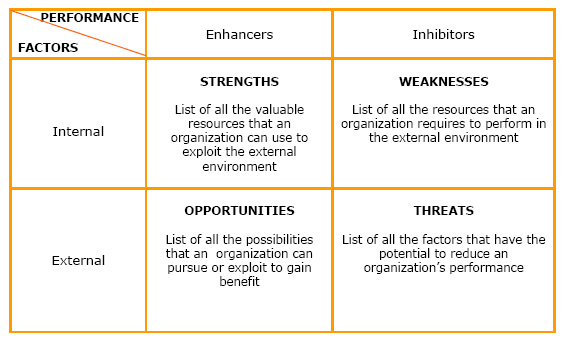Difference between revisions of "SWOT Analysis"
From Learning and training wiki
Chantal joly (Talk | contribs) |
Chantal joly (Talk | contribs) |
||
| Line 25: | Line 25: | ||
#The facilitator then collects all the paper cards and place them on a board. Inputs that are redundant are discharged | #The facilitator then collects all the paper cards and place them on a board. Inputs that are redundant are discharged | ||
#The same procedure is repeated for weaknesses, opportunities and threats. | #The same procedure is repeated for weaknesses, opportunities and threats. | ||
| − | #Categorize all the SWOT factors into the [[#Job Aids|Matrix]] and work to build consensus around | + | #Categorize all the SWOT factors into the [[#Job Aids|Matrix]] and work to build consensus around their placement. |
The situation is then analyzed with the objective of identifying ways in which the organization’s strengths can be built,upon to overcome the identified weaknesses, and opportunities can be taken to minimize threats. | The situation is then analyzed with the objective of identifying ways in which the organization’s strengths can be built,upon to overcome the identified weaknesses, and opportunities can be taken to minimize threats. | ||
A strategy for making improvements is formulated and subsequently developed, using any planning tool. <ref>[http://www.quickmba.com www.quickmba.com] (13 August 2008), [http://www.wikipedia.org Wikipedia] (13 August 2008), Project Cycle Management Guidelines, European Commission, 2004</ref> | A strategy for making improvements is formulated and subsequently developed, using any planning tool. <ref>[http://www.quickmba.com www.quickmba.com] (13 August 2008), [http://www.wikipedia.org Wikipedia] (13 August 2008), Project Cycle Management Guidelines, European Commission, 2004</ref> | ||
Revision as of 09:43, 15 October 2008
| A tool that identifies the Strengths, Weaknesses, Opportunities and Threats of an organization. Specifically, SWOT is a basic, straightforward model that assesses what an organization can and cannot do as well as its potential opportunities and threats. The SWOT analysis takes the information from an environmental analysis and separate it into internal (strengths and weaknesses) and external issues (opportunities and threats). Once this is completed, the SWOT analysis determines what can be of assistance to the organization in accomplishing its objectives, and what obstacles must be minimized to achieve desired results. [1] |
|
To conduct a SWOT analysis identify the following four categories of the SWOT Matrix:
Strengths and Opportunities are identified as enhancers to desired performance, while Weaknesses and Threats are inhibitors.[2]
SWOT Matrix
Step by Step
The situation is then analyzed with the objective of identifying ways in which the organization’s strengths can be built,upon to overcome the identified weaknesses, and opportunities can be taken to minimize threats. A strategy for making improvements is formulated and subsequently developed, using any planning tool. [3]
Job Aids
|
References
- ↑ www.answers.com (20 August 2008), www.netmba.com (20 August 2008), en.wikipedia.org (20 August 2008)
- ↑ www.businessballs.com (3 October 2008), web.worldbank.org
- ↑ www.quickmba.com (13 August 2008), Wikipedia (13 August 2008), Project Cycle Management Guidelines, European Commission, 2004
